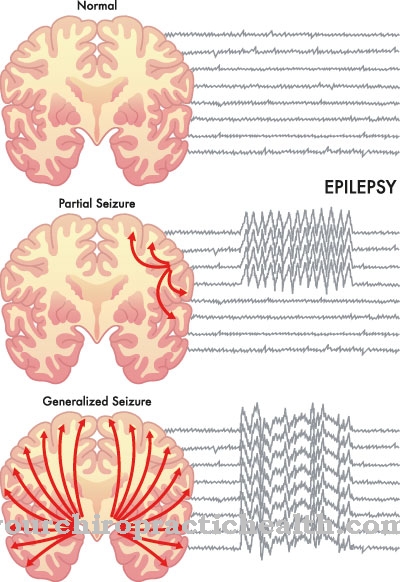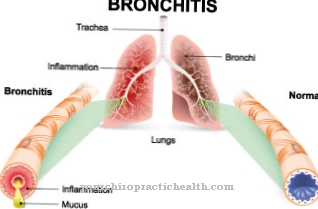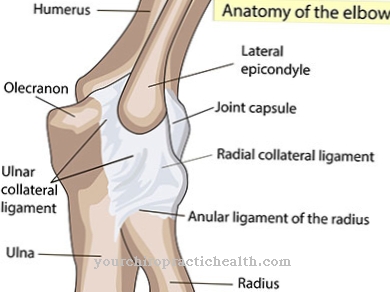At the Hermansky-Pudlak syndrome it is a hereditary disease that occurs very rarely. The disease is also abbreviated in numerous cases HPS designated. The Hermansky-Pudlak syndrome is characterized by the fact that the people affected mainly suffer from typical disorders and abnormalities of the skin.
What is Hermansky-Pudlak Syndrome?

© 4th Life Photography - stock.adobe.com
Basically, Hermansky-Pudlak syndrome is a disease that only occurs with a very low frequency in the population. For this reason, there are hardly any reliable data on the disease and its epidemiology at the moment. What is known so far is only that the disease occurs sporadically all over the world.
There is a geographical peculiarity in the occurrence of the disease. Because the Hermansky-Pudlak syndrome appears more frequently in the north-west of Puerto Rico. The reasons for this are currently largely unclear. In the course of time, 400 people suffering from or suffering from Hermansky-Pudlak syndrome have already been registered at this location.
This means that the disease has a frequency of 1: 8,000 in this region. Corresponding data on the frequency of Hermansky-Pudlak syndrome are not yet available for German-speaking countries. Basically, the substance ceroid is deposited in the so-called melanocytes, lysosomes and serotonous granules within the platelets as part of the disease.
Hermansky-Pudlak syndrome was first described by Pudlak and Hermansky in 1959. In honor of these authors, the disease was named Hermansky-Pudlak syndrome.
causes
The Hermansky-Pudlak syndrome and its development are characterized by the interaction of several factors. First of all, the lysosomes and related vesicles are relevant for the formation of the disease. At the beginning of development, these two substances go through similar processes.
These substances include various organelles, for example granules, serotonous granules or lysosomes. These vesicles and lysosomes are responsible for the typical symptoms and symptoms of Hermansky-Pudlak syndrome. Above all, defective functions of these substances play an important role in the development of the disease.
The typical albinism in the context of Hermansky-Pudlak syndrome is due to an incorrect synthesis of melanin. Melanin is formed in the melanosomes. The bleeding tendency is the result of the fact that in the event of bleeding the so-called platelets do not stick together and form lumps.
This will stop the bleeding under normal circumstances. The serotonous granules also play an important role in this process. Finally, the fibrosis of the lungs is caused by special defects within the so-called alveolar cells.
Symptoms, ailments & signs
Hermansky-Pudlak syndrome is characterized by a number of signs and symptoms that indicate the disease. The individual symptoms differ in their intensity and severity depending on the individual case. Some symptoms may be more pronounced than others.
Albinism, which shows up on the skin of the affected person, is particularly typical of Hermansky-Pudlak syndrome. Albinism may also occur on the conjunctiva. In addition, patients with Hermansky-Pudlak syndrome usually suffer from pulmonary fibrosis and an increased tendency to bleed.
Diagnosis & course
As part of the diagnosis of Hermansky-Pudlak syndrome, it is first essential to take a medical history. The attending physician asks the patient during a conversation about previous illnesses, characteristics of the personal lifestyle and possible genetic dispositions. In this way, the doctor receives relevant information to help him make the diagnosis.
In addition, the clinical appearance plays an important role in the diagnosis. The characteristic symptoms of Hermansky-Pudlak syndrome reinforce the suspicion that the disease is present. The hypopigmentation of the skin and hair in particular indicates the disease.
There is also the option of performing various genetic tests. Changes in certain genes lead to the development of Hermansky-Pudlak syndrome. Such a gene is believed to be responsible for the increased occurrence of the disease in Puerto Rico and can be identified through a laboratory test.
Complications
Hermansky-Pudlak syndrome mainly affects the patient's various skin areas. The actual complaints and complications differ in all patients, which is why no general prediction is possible in this case. However, albinism occurs in many cases due to Hermansky-Pudlak syndrome.
This usually has no particular negative effect on the patient's body and does not have to be associated with health hazards. However, in some cases, albinism leads to an increased tendency to bleed. Even very minor injuries can cause severe bleeding and the risk of internal bleeding increases. In the worst case, the patient suffers from blood loss and the associated symptoms.
It is not uncommon for Hermansky-Pudlak syndrome to have a negative effect on the patient's psyche. In many cases, there is a decreased self-esteem and continued inferiority complexes. These complaints can usually be treated by a psychologist without complications.
Direct treatment for Hermansky-Pudlak syndrome is not possible. In most cases, vaccinations are given to help prevent inflammation. Life expectancy is not influenced or reduced by Hermansky-Pudlak syndrome.
When should you go to the doctor?
Patients with albinism should see a doctor immediately. Usually, Hermansky-Pudlak syndrome is noticed immediately after birth and treated immediately. In less severe cases, the sick person has to clarify the symptoms himself. The typical symptoms, which definitely require a medical diagnosis and treatment, include noticeable skin changes, an increased tendency to bleed and pulmonary fibrosis.
Pulmonary fibrosis manifests itself among other things by shortness of breath, shortness of breath and dry cough. If these complaints occur and do not resolve on their own after a week at the latest, medical advice is required. If there are other signs of a serious illness, it is best to speak to your family doctor immediately.
In the event of severe complaints, an emergency doctor should be called or the person affected must be taken to the nearest clinic quickly. In addition to the family doctor, a specialist in skin diseases or a specialized clinic for hereditary diseases can also be visited. In case of doubt, the medical emergency service is the right contact.
Doctors & therapists in your area
Treatment & Therapy
With regard to the treatment of Hermansky-Pudlak syndrome, it should be noted that there are currently no causal therapy methods. Various studies indicate that glucocorticoids also do not significantly affect the prognosis or the progression of the disease. For this reason, there is only the option of symptomatic therapy for Hermansky-Pudlak syndrome.
Lung fibrosis may be positively influenced by not smoking. In order to avoid further complications or to reduce their likelihood, appropriate vaccinations are recommended, for example against inflammation of the lungs.
A vaccination against pneumococci and influenza viruses is also carried out by many doctors. It is important that the patient see a doctor as soon as possible if they suspect Hermansky-Pudlak syndrome.
prevention
At the present time there are no effective measures and possibilities for effective prevention against the development of Hermansky-Pudlak syndrome known. This is primarily due to the fact that the condition is a genetic disorder. For this reason, it is not possible to influence the causes.
If Hermansky-Pudlak syndrome is present, it is much more important to diagnose the disease quickly, to differentiate it from other diseases and then to start appropriate therapy. In this way, the quality of life of the affected patients can be increased and the prognosis of Hermansky-Pudlak syndrome can be positively influenced.
Aftercare
Since Hermansky-Pudlak syndrome is a hereditary disease, the measures or options for follow-up care are very limited. The person concerned should always carry out a genetic examination and counseling if they want to have children so that the syndrome does not recur in the children. In general, patients rely on lifelong therapy to alleviate the discomfort and complete cure cannot be achieved.
Hermansky-Pudlak syndrome is usually treated by taking medication. When taking this, the correct dosage must always be ensured, whereby the doctor's instructions must of course be followed. In the case of children, the parents in particular must ensure that the medication is taken correctly and regularly.
Various vaccinations should also be given to prevent diseases or infections. Since Hermansky-Pudlak syndrome can lead to severe complications, parents should consult a doctor as soon as the first symptoms or signs of the disease appear. Those affected often need the help and support of their own families in their lives. Loving and intensive conversations are also important in order to prevent psychological upsets or depression.
You can do that yourself
In the case of Hermansky-Pudlak syndrome, the patient unfortunately has very few options for self-treatment. Since most people suffer from an increased tendency to bleed, any injuries or hazardous work must be avoided.
This avoids complications due to high blood loss. Even in the case of surgical interventions or ordinary visits to the doctor, the doctor should always be informed that the person concerned suffers from Hermansky-Pudlak syndrome.
If the person concerned suffers from albinism or another pigment disorder, this cannot be treated directly. However, psychological complaints or inferiority complexes can be remedied by talking to other affected persons or with the support of friends and relatives. Above all, your own partner can support the patient.
Various vaccinations can also alleviate the symptoms of the syndrome, so that, for example, inflammation in the lungs can be avoided. Those affected should carry out any vaccinations to protect themselves against various pathogens. Since the syndrome can also lead to pulmonary fibrosis, smoking should definitely be avoided. This can also increase the patient's life expectancy.



























